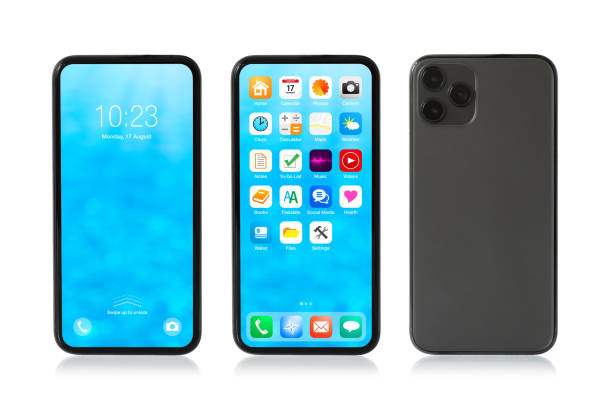
phone on white background. Isolated 3D illustration
In an unprecedented move, two industry-leading technology companies—OnePlus and Oppo—have announced plans to collaborate on product development, marketing initiatives, and other corporate strategies. OnePlus and Oppo are multinational smartphone manufacturing brands owned by parent company BBK Electronics Corporation. OnePlus is known for its flagship devices that offer premium build quality coupled with cutting-edge hardware at an affordable price range; whereas Oppo is widely regarded for its research and development of innovative user interfaces.
This transformative collaboration between OnePlus and Oppo marks a significant shift in the competitive smartphones industry, which Samsung has dominated, Apple, Huawei, Xiaomi, Vivo and other major brands for years. Through this partnership between these two tech powerhouses, consumers will benefit from improved product portfolios and enhanced customer experiences across both product lines.
Overview of OnePlus and Oppo
OnePlus and Oppo are two of the biggest names in the smartphone industry today. Both companies have a strong presence in the market, and now OnePlus will deepen its strategic integration with Oppo.
This article will explore the relationship between the two companies, the implications for both companies, and the potential for collaboration and innovation.
OnePlus
OnePlus is a Chinese manufacturer focused on producing quality yet affordable smartphones. Founded in December 2013, the company has grown rapidly, becoming a global leader in the mid-range smartphone market. OnePlus phones are praised for offering a premium user experience at an affordable price point, with features such as fast processors and large displays. In addition, OnePlus also offers budget phones designed specifically for emerging markets such as India and China.
Conversely, Oppo is another Chinese smartphone maker and market leader in the mid-range to low price segment of phones. Oppo focuses on bringing high-quality yet affordable phones to consumers looking for lower cost options to their premium counterparts from Samsung, Apple and others. Oppo devices have traditionally featured impressive camera technology and long battery life — making them highly popular among many users in Asia and other parts of the world where mobile users prioritize affordability over other features and specs.
Both OnePlus and Oppo produce handsets based around the same kind of cost/value equation: offer high quality components at a price point attractive to consumers looking for value without sacrificing specs too much — this means that their phones feature powerful CPUs; decent RAM amounts; beautiful displays; good camera sensors; plenty of storage; etc all without breaking the bank. And while they may have somewhat different aesthetic approaches or product lines, they both still target those seeking an excellent device without breaking their budget too much. As OnePlus expands globally while Oppo strengthens its position in Asia, they might eventually be able to tap into each other’s strengths to further strengthen their respective positions as some of the leading players in the mobile industry worldwide.
Oppo
Oppos is a Chinese multinational electronics company founded in 2004 and based in Guangdong, China. Oppos manufactures smartphones and sells them mostly in China, India, and most parts of Asia. In addition, the company has additional offices globally. The company primarily focuses on creating high-performance phones with its flagship lines, including the Reno, Find, and AX Series.
OnePlus began as a division of Oppo in 2020 to design a flagship phone to challenge Apple’s iPhones at a much lower cost. OnePlus has continued to produce affordable flagship phones with unique designs and features such as extensive customization capabilities with OxygenOS (OnePlus’ custom operating system). With its premium specs and affordable prices, OnePlus has found success amongst budget-conscious customers worldwide.
The combination of Oppo’s engineering prowess with OnePlus’ vision for providing flagship quality at an accessible price point makes for an exciting partnership that will likely result in many more attractive offerings from both companies. It will be interesting to see how Oppo and OnePlus continue innovating on their designs going forward.

OnePlus will deepen its integration with Oppo
OnePlus and Oppo have been allies for some time, but the two tech companies are taking their relationship to the next level. In the coming months, OnePlus will deepen its integration with Oppo, allowing the two companies to offer more features, services, and products than ever.
Let’s look at this new relationship and how it may affect both companies.
History of the Companies’ Relationship
OnePlus and Oppo have been business partners since 2013, when Oppo Electronics became a major investor in OnePlus, providing financial support and additional resources to the independent startup. The two companies have collaborated on various products to develop innovative marketing campaigns and new devices catering to young Chinese consumers. By 2014, OnePlus had become the fourth largest brand in China’s smartphone market thanks largely to their partnership with Oppo.
Since then, OnePlus and Oppo have continued to work together closely. In 2017 they announced a new collaboration to integrate the two companies’ production lines more closely: Oppo would lend its manufacturing expertise and supply chain resources to OnePlus while maintaining separate branding focuses on different global markets. This marked a significant milestone in their relationship, allowing them both to reduce costs and remain independently owned within their respective countries.
More recently, in 2019, OnePlus announced it would acquire the remaining stake of its main investor, Shenzhen BBK Electronics Corp., from OPPO thus becoming completely independent from their partner company. Despite this change however, Oneplus stated that they will continue working with OPPO as both brands were committed to developing innovative products for their target markets worldwide.
OnePlus’s Deepening Integration with Oppo
OnePlus has established a deep strategic partnership with Oppo that goes beyond promoting shared products. Early on, both tech companies had agreed to stringent terms to ensure their collaboration was beneficial and successful. Some of the shared commitments include joint research and development (R&D) activities, manufacturing collaborations, and marketing initiatives.
Regarding R&D, Oppo and OnePlus have vowed to test out their respective products together. This means they will be able to adapt their technology quicker while ensuring they can bring out better products faster. Additionally, this partnership also allows OnePlus access to a larger pool of components and the know-how of Oppo’s manufacturing processes, which helps them reduce cost and gain a competitive advantage in the market over rivals like Samsung and Apple Inc.
Manufacturing collaboration also played an important role in this partnership, allowing both companies higher production efficiency while cutting down on costs due to joint buying power. This was enabled by combining their respective talents from different supply chains, enabling them more flexibility from cost cuts from “reverse integration” – when suppliers become buyers instead of manufacturers becoming suppliers for certain components.
Finally marketing plays an important role in this partnership as it allows for more efficient utilization of resources for each other’s campaigns through cross-promotion opportunities as well as shared intelligence on customer preferences which helps each brand widen its breadth quickly compared to having independent silos for each one respectively.

Benefits of the Companies’ Collaboration
OnePlus and Oppo have recently announced an intention to deepen their integration to strengthen the two companies’ presence in the global market. By combining their resources and capabilities, the two companies can benefit from each other’s expertise and technology to help them improve their products and differentiate their portfolios from their competitors.
This article will discuss the potential benefits that the companies’ collaboration may have for them.
Increased Access to Resources
The collaboration between OnePlus and Oppo is mutually beneficial to both companies, as it will provide increased access to resources, technologies, expertise and R&D capabilities.
OnePlus will gain access to Oppo’s extensive supply chain network, 5G technology R&D capabilities, further expertise in camera technology, VOOC flash charging technology and other products and related services. This will enable OnePlus to expand its product portfolio in the global market while remaining competitive on price.
Oppo’s strategic collaboration with OnePlus provides access to more markets and bolstered resources in software engineering innovation & higher research & development capabilities. This could accelerate the development speed of Oppo’s mobile phone offerings while allowing them to better cater for a global audience.
This greater pool of collective resources from both companies should help create more innovative products considering customers’ preferences across varying geographic regions. Therefore, each company will be able to expand its target audience and grow their market share by leveraging emerging technologies.
Improved Brand Recognition
Working together can benefit both companies, offering improved brand recognition, increased R&D capabilities, and access to each other’s products. OnePlus is already known for its high-end flagship phones, but with their collaboration with Oppo, they will have a more expansive product portfolio and access to the Chinese market. This could mean they would have a larger customer base and increased visibility in the smartphone industry.
In addition to sharing resources, the two companies can improve brand recognition across different markets by collaborating with multiple brands in different markets. For example, Oppo’s presence in China means that OnePlus can leverage this large user base and make them aware of their phones. Similarly, Oppo will benefit from OnePlus’ name recognition in western markets. This could increase sales for both companies and create opportunities for innovation through cross-brand technology sharing.
The collaboration between OnePlus and Oppo also allows for more efficient resource allocation in research and development (R&D) areas. Both companies offer similar products but with different features which mean greater flexibility when it comes to innovation; this would result in better user experience on their respective devices while helping them stay ahead of competition. Furthermore, as these two firms work under the same umbrella company, BBK Electronics Group, they will likely pool resources by utilizing one another’s expertise when developing new technologies. This advantage will be integral to staying competitive in today’s smartphone market.
Cost Savings
One of the key benefits to the OnePlus – Oppo collaboration is the cost savings that come with not having to develop all components, solutions and services – instead, focusing on one aspect. For starters, combined purchasing power can lead to cost savings in materials and components, allowing companies to buy in bulk at competitive prices. Companies can also save money by utilizing existing technologies and functionalities from both firms, increasing efficiency by avoiding reinventing the wheel for each new product. Furthermore, shared research and development efforts with two teams working together leads to quicker time-to-market with reduced costs.
In addition to overcoming the economic challenges of launching new products on tight budgets, collaboration between two firms helps bring innovative approaches and creative energy from each firm’s distinct offerings into a meaningful whole. Companies no longer need to invest in their research & development; instead, using existing experiences within their partner companies’ portfolio will help reduce cost significantly while maintaining innovation capabilities. Also, pooling resources such as marketing strategies, market analysis information and establishing common goals/strategies across both companies will help amplify a larger voice to help reach wider customer bases more efficiently and quickly at a lower cost.

Challenges of the Companies’ Collaboration
The collaboration between OnePlus and Oppo comes with several challenges. Integration of their respective products and services could be difficult to implement, due to their different strategies, resources and customer base.
Furthermore, OnePlus will need to deepen its integration with Oppo to make the collaboration successful, which could lead to potential problems such as duplicating production efforts.
Let’s explore the challenges of OnePlus and Oppo collaboration in more detail.
Potential Loss of Brand Identity
One of the potential challenges of the companies’ collaboration is the potential for a lost or diminished brand identity. Despite the synergies of their past collaborations and mutual business interests, each company maintains its corporate identity and vision. As such, it can be difficult to balance the promotion of each business while still preserving both identities.
To ensure that both companies’ unique brands remain intact, they must clearly define their roles in this partnership. Each company is playing to its strengths and avoiding overextending into one another’s markets or areas of expertise. Additionally, they must work closely together to develop consistent campaigns and messages while retaining distinct promotional strategies targeted at different customer segments and audiences. Finally, transparency throughout all stages of collaboration is crucial to be sure that neither enterprise’s initiatives are compromised during the process.
Potential Loss of Control
One potential challenge to the companies’ collaboration is the risk of a loss of control. As the two companies work together, they must feel confident that the other will abide by their commitment and not become too powerful. This may be difficult if one company feels like it has more control over the other. Additionally, this collaboration may potentially lead to a loss of autonomy for both companies, which could have consequences regarding their strategies and their successes and failures in the market.
For a successful collaboration between OnePlus and Oppo, both companies must be aware of this potential risk and take steps to ensure that their partnership is mutually beneficial. They should set clear rules and boundaries from the start, including where there are different interests and areas of responsibility. This can help provide clarity if disputes arise between them, while also giving both parties confidence in understanding how decisions are made during the collaboration process. Both sides must demonstrate a commitment to compromise when needed for this venture to succeed.
Conclusion
OnePlus and Oppo have established their relationship as partners in commerce and cooperation. OnePlus is the flagship brand of BBK Electronics Corp (BBKV) and Oppo has agreed to work together strategically. OnePlus focuses on innovative product design, premium quality, and high performance across all products; while Oppo focuses on camera functions and battery life. Through mutual investments and technologies, both companies can leverage each other in their core areas to create better mobile phones for their users.
Both companies have committed massive resources to collaboration in research, development, manufacturing and marketing to push boundaries in a rapidly advancing industry. Early results of these collaborative efforts are already visible through the launch of certain groundbreaking smartphone models such as the OnePlus 7T Pro 5G McLaren Edition and the OPPO Reno 10x Zoom Edition. Both products were made at two separate factories managed by BBKV, thus setting a new benchmark for accountability within the electronics industry.
Going forward, it is anticipated that further collaboration between company executives will facilitate the discovery of new synergies that can be leveraged by both parties to further their respective product lines with faster speed-to-market timescales for innovations in future mobile devices.


